Your handy 1986–93 Toyota Supra (A70) buyer’s guide
Why, why, why does half the world seem to ignore this Supra? The later fourth-generation Supras are sports-car royalty thanks to a more powerful turbo engine and 20 years of appearances in blockbuster movies, all while the third-generation, A70 Supra languishes, comparatively ignored. Yet, the 1986.5 to 1993 Toyota Supra is one of the best-looking grand touring cars of the era, with engine power (especially after 1987) that was competitive with most everything else from that time period.
You have to appreciate the A70 Supra for what it was: A pre-Lexus touring car that was sportier and much better-looking than the SC 300, with sharply angled styling instead of the Melted Bean school from the 1990s. Yes, they’re heavy, but they never took on the bloat of the Nissan 300ZX. On paper, they’re not fast, but at the time, the Turbo was the fastest Japanese car available, so it’s time to look at these cars with fresh eyes and understand what an amazing value they are. Not many cars this good are sitting there for the taking like the A70.
1986.5
The A70 Supra arrived in the United States as a late-model introduction. Based on the Z20 Toyota Soarer platform, the Supra officially, completely divorced itself from the Celica family, retaining its inline-six, rear-drive bones.
Like every Supra through the A90, the car was engineered by a person who should be as much an automotive household name as J. Mays or Peter Schreyer. Yukihiko Yaguchi is a bona fide legend, mostly recognized for his role as the Emeritus Chief Engineer of the Lexus F brand. But Yaguchi’s hands are all over four of the five Supra generations, and most notably the A70. Also present during the A70’s development were almost every one of the people behind the much ballyhooed Lexus LFA. Contemporary articles on the A70 never even hinted that the Supra had a human behind it, as if the car just hatched, fully formed out of an algorithm just inside Toyota’s Tahara plant. But Yaguchi was busy, prodding the car along, laying the groundwork for what would eventually be the performance cars for which Lexus would build its sports-car reputation: capable automobiles that were easy to drive for anyone at any driving level, suitable for fast runs from one side of the country to the other. And Hiromo Naruse was there, flogging the Soarer-based suspension that Haruhiko Tanahashi developed on the Nürburgring, making the A70 the first Toyota prototype ever to be evaluated there.
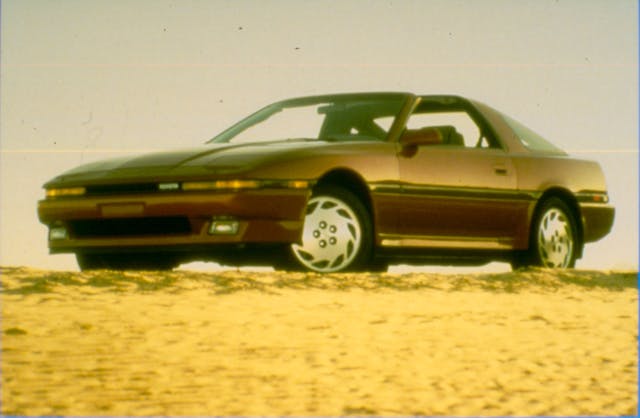
Perfectly in the style of the mid-1980s, the design wasn’t fully appreciated, even at the time. Arthur St. Antoine at Car and Driver wrote in 1987, “Otherwise, the design—like it or not—is unchanged. Though we’ve never felt that the current Supra’s shape is as distinctive as, say, the Corvette’s, it is beginning to grow on us.” But put its design in the ring with anything from 1986, from any nation—300ZX, 944, RX-7, Corvette—and at a minimum, the design is competitive. At best, it blows some of those competitors out of the water.
St. Antoine continued with the chief complaint about the A70: Its weight. “Our only real complaint is that the car looks every bit as heavy as it is,” he wrote. You could argue that it is a valid criticism as the A70 weighed almost 3500 pounds, but what didn’t? It’s 200 pounds heavier than the Corvette, but that comparison never made any sense anyway. The A70 was more like a Japanese IROC-Z or Porsche 928.
In the plus side of the ledger, the 1986.5 Supra had everything that made a grand tourer special in that era: a huge-bore 3.0-liter 7M-GE inline six with electronic ignition and fuel injection, dual overhead cams, a multi-link suspension at every corner, four-wheel disc brakes, a five-speed manual transmission (not to mention a surprisingly good four-speed automatic), and a limited-slip differential.

Inside, the Supra was magic. Leave the button-happy dash aside for a moment, and compare the seats in this car to anything made at Toyota in 2021. This car wins out every single time. The standard cloth seats are just as adjustable, but the optional “glove-soft” leather chairs described in the marketing materials are absolutely gorgeous, and as comfortable to use as they are beautiful to look at. In 1986, the science of ergonomics was so unfamiliar that Toyota actually defined it in the brochure. Power adjustments controlled lumbar and side supports, while manual controls offered custom fit for every frame. The headrests not only raised and lowered, but tilted, and the recline feature was step less, offering infinite adjustment within the range. The floor of the car was 40 mm lower than the one that preceded it, and the seat offered 30 mm more travel, in order to make the Supra more comfortable for every driver and passenger. “A large interior with the fit of a fine suit of clothes,” the marketing materials suggested.
The weight would’ve been less of an issue had the Supra debuted with a turbo midway through the 1986 model year, but it didn’t. It was offered with a lone engine, the 7M-GE, delivering 200 hp at 6000 rpm and 185 lb-ft of torque at 4800 rpm. Smooth, nearly bulletproof, quiet—but not fast: “PERFORMANCE WITHOUT COMPROMISE” read the brochure in 1986. That was perhaps very generous, as the compromise was clearly laid out right underneath that line: “0 to 60 in 7.33 seconds.” For a normally aspirated car, that performance wasn’t necessarily disappointing. A Porsche 944 without a turbo took a half-second longer. A Z28 with a 305 was going to take two seconds longer to get there. The problem? There was no other engine option that first half-year, and that went a long way toward setting the tone the press for this car for years afterward.
In 2021, anything north of a Camry is equipped with variable suspension settings, but in 1986, optional Toyota Electronically Modulated Suspension (TEMS) was revolutionary, automatically matching suspension performance to driver input. Within that, the driver could choose two suspension settings—Normal and Sport. Normal allowed the shocks to work in Soft, Medium and Firm modes, while Sport tightened up the ride to Medium and Firm modes.
Supra colors were available in single color (White), Pearl Clearcoat (White, Red, Dark Blue) Metallic Clearcoat (Amethyst, Brown, Light Blue, Black) and optional two-tone (Dark Blue/Blue or Beige/Brown). Interior colors were Blue, Maroon, Gray, and Beige. Toyota sold 34,832 Supras in 1986, the second best year of sales in the car’s entire history. One of the coolest options available was the Sport Roof, a steel Targa-style top affixed by four bolts, stowable in the cargo compartment. With the roof in place, the Supra achieved a 0.33 drag coefficient, pretty rarified air in 1986.
1987

In retrospect, Toyota may have been wise to hold off selling the Supra entirely until the Supra Turbo was ready to go in 1987. The turbo addressed about 95 percent of any complaints about the car’s performance. Air-to-air intercooled with a water-cooled center bearing, the turbocharger dialed the 7M-GTE’s performance to 230 hp at 5600 rpm and 246 lb ft of torque at 4000 rpm, dropping the 0 to 60 time to 6.4 seconds, a second and a half faster than independent testing showed for the normally aspirated car. Suddenly, the Supra’s weight wasn’t such an issue.
Like the natural-breathing version, the Supra Turbo was available with a manual or a four-speed automatic, but the five-speed was unique to this car. Instead of the W58 manual in the Supra, the Supra Turbo got an Aisin R154, with taller second and third gears, and a slightly shorter fifth for snappier response in overdrive. The turbo was also packaged with most of the goodies on the optional side of the normally aspirated car’s menu. The Sports Package was standard, and included a limited-slip differential, the advanced Toyota Electronic Modulated Suspension System (TEMS), and headlamp washers.

The option list grew to include two important items for 1987. First was the anti-lock braking system, optional for both the Supra and the Supra Turbo. After 1987, Toyota killed the optional two-tone Beige and Brown, which is a lot more handsome than it sounds. Sales in 1987 remained strong, at 29,907 units.
1988
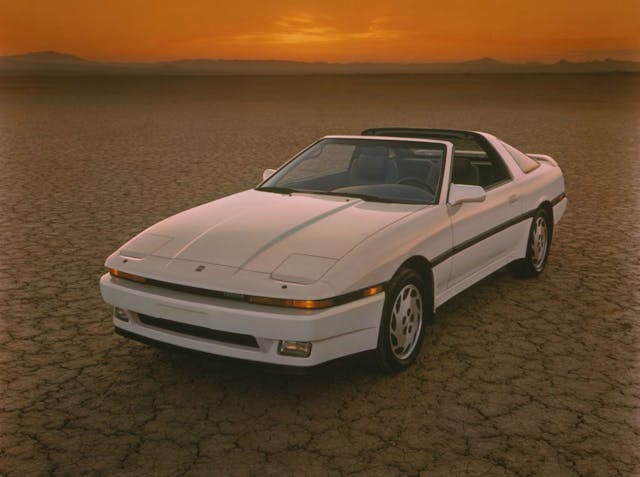
Only two significant changes occurred in the 1988 model year. First, the two-tone brown paint scheme from last year disappeared. Second, spoiler-equipped Supras got a nicer trapezoid design for the center high-mounted stop light, rather than the uninspired rectangle on the 1986.5 and 1987 cars. Toyota produced 19,596 Supras for 1988.
1989
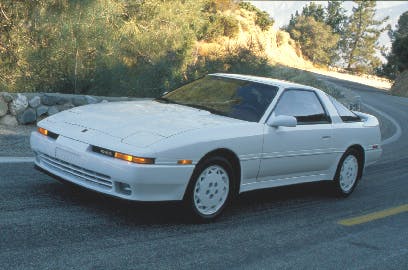
There were a host of minor updates for the 1989 model year. None changed the design significantly, but the Supra received a new front bumper with a lower grille integrated into its design, new turn indicators, updated side mirrors, and fog lamps. 1989 was a big year in terms of future collectibility, as this was the debut of the White Exterior Appearance Package. If you ask anyone who lived through the late 1980s to conjure an image of the A70 Supra, they’re probably going to picture a car equipped with the White Package. These monochrome white Supras featured matching white moldings, and in 1989 and 1990, white saw-blade alloy wheels.
There were changes inside, too. From 1986.5 to 1988, the center stack was black with silver buttons, a design that frankly looked out of a different time when the car was new. In 1989, the buttons went black with white print, for a much more contemporary look. The steering wheel design also changed, albeit only slightly. From 1986.5 to 1988, the steering wheel mounted cruise control buttons were in an odd place on the lower vertical third spoke of the wheel. The design change moved them to the two horizontal spokes, where they were accessible without removing hands from the 9:00 and 3:00 positions.
The Supra Turbo’s main revision was to the rear spoiler. The first two years, the spoiler was one piece, but for 1989, the Turbo got a more aggressive three-piece spoiler design with pronounced tips mounted to the tops of the rear quarters, integrated with the power antenna. In 1989, Toyota produced 14,544 Supras.
1990

The bulk of revisions for the 1990 model year were to the dash and steering wheel. The one-year-only thumb-operated cruise control buttons moved again, this time to a small stalk on the right, which will be familiar to anyone who has driven a Toyota in the last 30 years. That change was necessitated by the bigger news for 1990: the standard driver’s side Supplemental Restraint System (i.e. an airbag) took up a lot of real estate in the center of the wheel, and changed the wheel from a sporty three-spoke to a more standard issue four-spoke. The wheel was still unique to the Supra, as it sported a rim wrapped in leather, with the Supra script prominently displayed.
It’s worth noting the dramatic impact of the 1990 Recession on Supra sales: For 1990, Toyota sold 6,419 Supras, a free fall of almost 56 percent. Sadly, Supra sales would never recover, even after the introduction of the A90.
1991

For 1991, the saw blade wheels were replaced with a more modern five-spoke alloy wheel. For the first time, the Toyota oval logo was mounted on the front fascia. A total bummer for normally aspirated, open-air Supra fans occurred this year, as the Sport Roof became optional on the Supra Turbo only. Supra buyers were limited to a more traditional steel power sunroof. Sales dipped by almost half again, to 3623 cars in 1991.
1992
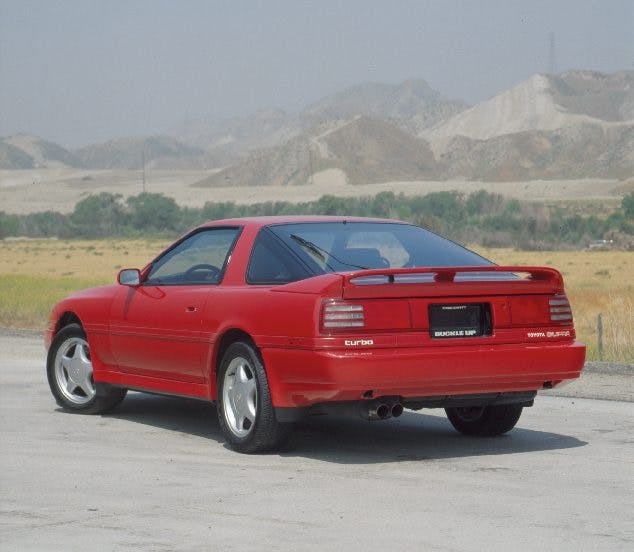
Changes were sparse for the final year of A70 production. Look for a dual cupholder in the (super convenient) location under the console lid, so you can knock your Big Gulp out every time you attempt to shift. This last year of A70 production, sales dropped by more than two thirds to 1193.
Before you buy
Rust is a problem to look out for, but it’s all relative. You may think that a Japanese car from the mid-1980s to the early 1990s would be especially prone to rust, but if your reference point for corrosion is something like a Fiat 124, you’re going to be pleasantly surprised. These cars do have areas where rust is an issue, including the tray on the inner fender where the battery sits, the wheel arches, and the weld on the door sill where the rear fender meets the rocker panel. Rust can also be a concern in the spare tire well, specifically due to the rubber seal on the rear hatch. Rust issues also get worse if a car had significant body repair from a collision, but that’s not Supra-specific. For the most part, you don’t see Mk3 Supras with massively blown-out floors, rocker panels, or lower doors.

For a while, the high-pressure side power steering hose was insanely expensive—something like $1000 from Toyota—and now they’re officially “unobtainum” from the factory. Luckily Driftmotion has replacements for reasonable money today. Engine knock sensors will throw Code 52, and the consensus among Supra owners is that it’s almost never the sensor (around $200 to replace) and almost always a frayed wire ($20 to fix). Speaking of wiring, turbo cars especially run hot, and 30-year-old wiring tends to bear the brunt. Speedometers and odometers are known to go funky or stop working altogether. A70s have three components to make the speedometer work: a short cable, a long cable and a driven gear in the cluster. Any and all can fail. The conventional wisdom is to remove the cluster and drive the car and see if the end of the cable turns to diagnose what the issue is.The heat can stop working, and that’s almost always the fault of a bad heater control valve.
These are all minor issues that you’ll find with any used car from the 1990s, and are more of an annoyance than an actual problem. The bigger deal is the dreaded “BHG” or blown head gasket. The issue ostensibly stems from incorrect assembly at the factory, specifically under-torquing the head studs by a factor of 20 to 30 lb-ft. Considering these cars are a minimum of 29 years old, the opportunity to re-torque that head has probably sailed, or the head gasket has already failed and been replaced. However, if you’re looking at a low mileage car that’s never had any engine work, it’s something to look into. The Supra Club of New Zealand has an excellent document detailing the issue, diagnostics, possible fixes and cost estimates.
Valuation
The Hagerty Valuation Team provided some excellent insight on the prices that Mk3 Supras are realizing, but please check here for the latest values. In very general terms, a third-gen Supra Turbo is worth a little more than twice what a normally aspirated Supra costs, regardless of year or condition. An automatic transmission is an automatic 15 percent price drop, whether you’re interested in a Supra or a Supra Turbo.

Prices are way, way up since 2013. A70 Turbos in #2 (Excellent) condition have increased by 212 percent since that time, and are climbing even more strongly than the MkIV cars, which have increased in value by 112 percent during the same time period. That’s a percentage, though. In dollars, the price difference is dramatic. A #2-condition A70 Supra Turbo will cost around $34,000 today. An A90 is going to cost $95,000. Clearly these Supras are from two different planets.
Looking at sales back to 2017, there is definitely an upward trend in Supra values, however, the most expensive A70 sold on Bring A Trailer in the last four years was just $30,250 in January of 2021, a gorgeous red Supra Turbo with a five-speed, a Sport Roof and 71,000 miles. If you factor in the destination charge, that’s only about $750 more than the car sold for when it was new. The bulk of Supra Turbos sold in the last 12 months hover in the $20,000 range. There are some super nice, low-mile, five-speed NA cars selling in the $12,500 range.

The median quoted value on an A70 Supra is $9500. That includes NA cars and Turbos. The quoted value on these cars is up 35 percent over the last five years, and the number of quotes has risen by 28 percent. Demographic data on these cars skews much younger than typical classic cars, which shouldn’t be surprising. Millennials quote 32 percent of the Supras insured by Hagerty, while making up just 19 percent of the classic car market. Gen-X is right behind, quoting 28 percent of Supras, while making up 31 percent of the market. Gen Z—representing just six percent of the entire market—quote 18 percent of Supras. Boomers quote just a bit higher at 19 percent but represent a comparatively large 38 percent of the total market. Pre-boomers don’t seem to care for these cars much, quoting just three percent of the Supras while making up seven percent of the overall collector car market.
Here’s our general thought: Values for A70 Supras aren’t likely to go anywhere but up. A clean Supra Turbo is going to cost you, but $30K may prove a bargain in the long run. That said, if you want a fast car, you can buy a 2021 Camry that will outgun the fastest A70 Supra ever built. If you can live with an amazingly clean, low-mileage, five-speed naturally aspirated Supra, there are some truly remarkable deals out there.
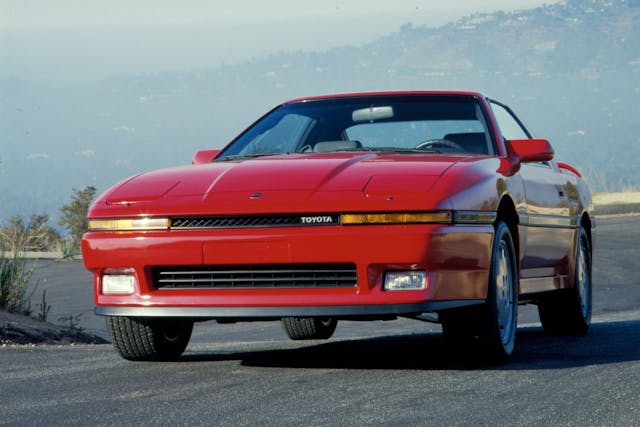


I have a 1986.5 toyota Supra A70 3.0 liter 7M-GE in line six with electronic injection,Duel overhead cam. multi -link suspecsion,,disc brakes,5 speed trans, Black exterior gray interior no rust anywhere all original except for the tires but they are z rated 27k original miles in great condition how much would it be worth.